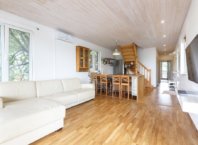As the world of architecture continues to evolve and transform, more designers are leaning towards materials that offer both functionality and aesthetic appeal. Among these contemporary materials, Exposed Aggregate Concrete has become a shining star in modern architecture. With its unique look and practicality, it oozes an industrial, edgy, yet sophisticated charm that is increasingly appealing to architects and homeowners alike.
The benefits of Exposed Aggregate Concrete aren’t merely skin deep. Its robustness, adaptability, and low maintenance requirement make it a reliable choice. Its wide range of textures and colours allow it to be versatile and fit a wide range of architectonic styles without compromising performance or aesthetics.
This increased visibility and preference for Exposed Aggregate Concrete in both commercial and residential properties indicate its significance in the modern architectural narrative. Its versatility makes it applicable in various contexts, whether indoors or outdoors, allowing it to set a dominating presence in trendy architectural plans.
The Unique Versatility of Exposed Aggregate Concrete

Ask any architect or builder about the dominant traits of a reliable construction material, and they would collectively respond with durability, aesthetic appeal, and adaptability. Fortunately, Exposed Aggregate Concrete ticks all these boxes and more, making it an undeniably unique material in contemporary construction.
Its durability is one of its standout attributes, being able to withstand heavy foot traffic, extreme weather conditions and offering low maintenance. The aesthetic properties of exposed aggregate emerge from its application process, where the top layer of concrete is removed to expose the aggregate, producing a visually appealing texture and colour composition.
Beyond its durability and aesthetics, Exposed Aggregate Concrete also boasts adaptability. Capable of mixing with other architectural materials like glass, crushed shells, or different stones, it can create an array of designs catering to a wide spectrum of architectural styles, thereby again proving its versatility.
Deep Dive into the Process of Exposed Aggregate Concrete
Understanding the process of Exposed Aggregate Concrete creation can deepen an appreciation of its distinctive appearance. It begins with a surface that has freshly poured concrete. A chemical retardant is applied to pause the setting of the top layer. Once the concrete has hardened, the top layer is washed away to reveal the aggregate underneath.
What gives Exposed Aggregate Concrete its distinctive appearance is the variety of materials used. This could range from pebbles to coloured glass or even seashells. The aggregate material used significantly impacts the overall look and feel of the finished surface.
One must also consider the impact of the local Australian climate on the concrete. Factors such as extreme heat, rainfall, or variations in temperature can affect the durability and appearance of the aggregate concrete, pushing designers to select materials that can withstand local climatic conditions.
The Expressive Texture of Exposed Aggregate Concrete
In architectural aesthetics, texture plays a vital role in adding depth, visual interest, and character to structures. Exposed Aggregate Concrete, with its variety of surface textures, offers distinctive tactile experiences, thereby enhancing the architectural dialogue.
The interplay of light with these textured surfaces elevates the aesthetic charm of Exposed Aggregate Concrete. The way the material catches and reflects light can create a captivating array of effects, shifting throughout the day and changing insights depending on the viewing angle.
Exposed Aggregate Concrete in Indoor and Outdoor Spaces
The functionality, versatility, and charm of Exposed Aggregate Concrete go beyond exterior applications. Across Australia, architects are increasingly employing it in contemporary patio designs, driveways, and walkways alike. Its robustness can withstand variable weather, thus making it an excellent choice for outdoor spaces.
Indoors, the growing trend sees Exposed Aggregate Concrete in floorings, countertops, and even wall treatments. Its grungy yet chic aesthetic creates a modern and stylish ambience, perfect for adding a distinctive touch to interior design trends.
Popular Australian Structures featuring Exposed Aggregate Concrete
A stroll around urban areas of Australia will reveal the extensive use of Exposed Aggregate Concrete in modern structures. Be it municipal buildings, corporate parks, or entire residential suburbs, the visible relationship between architecture and this versatile concrete gives Australia’s cityscape its distinctive look.
One famous example is the National Gallery of Victoria. Here, the usage of Exposed Aggregate Concrete extends from its outer facade to the interiors. The contrasting textures of the smooth and exposed concrete create a distinctive visual appeal, proving the marvellous effect of this concrete on architectural aesthetics.
Care and Maintenance: Ensuring the Longevity of Exposed Aggregate Concrete
Despite its high durability, ensuring the longevity of Exposed Aggregate Concrete requires some basic maintenance. Regular cleaning and occasional resealing can help maintain its aesthetic value and structural integrity. The sealed surface not only enhance its appearance but also protect it against stains and minor wear and tear.
Professional care can immensely enhance the lifespan of Exposed Aggregate Concrete surfaces. Experienced professionals have the necessary skills and tools to carry out deep cleaning, resealing, and any repairs if required, thus ensuring your investment looks and functions flawlessly for years to come.
Upfront and Long-term Costs of Exposed Aggregate Concrete
Admittedly, the upfront costs of Exposed Aggregate Concrete often seem higher compared to other traditional materials. The factors contributing to the cost include the type of aggregate used, the complexity of the job, and the finish desired.
However, considering its low-maintenance requirement and superior longevity, it becomes a rewarding long-term investment. The payoff of its splendid aesthetics combined with its remarkable resilience makes it a worthy asset for any modern architectural endeavour.
Conclusion: The Future of Exposed Aggregate Concrete in Modern Design
Exposed Aggregate Concrete has indeed cemented its place in modern design. Its extensive array of benefits, coupled with a distinctive aesthetic appeal, promises a bright future for this material in years to come.
This isn’t just a trend expected to fade away but rather a transformative element in architectural aesthetics. For architects and homeowners looking to integrate contemporary aesthetics with long-lasting functionality, this material offers an effective and visually appealing solution. Its journey seems to have just begun, and the horizon holds limitless possibilities.







